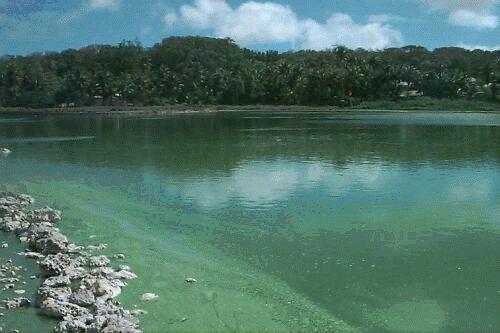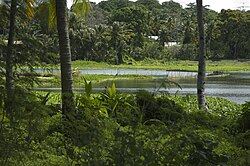Buada Lagoon
Largest inland waters of Nauru
The Buada Lagoon is the lagoon of the atoll island of Nauru. It is located in the central south-west of the island, in the district Buada and 1.3 km from the coast, as well as 5 meters above the sea level. Compared with other lagoons of atolls in the Pacific Ocean, the Buada Lagoon with approximately 3 to 4 ha is quite small. Because of their small size and unusual nature, it is often referred to as a lake.
In addition to the moqua well and a few other small ponds Buada the lagoon is the only source of fresh water in Nauru, although it 's more of brackish water with a salinity of 0.2 percent. The pH is 8, the water has a slightly greenish color. The lagoon is fed by the running surface water mainly during the monsoon from November to February. The average annual rainfall in the tropical climate is 2000 mm.
The lagoon is surrounded by dense palm forest and swamp, and hardly affected by the pollution of the former phosphate mines. Therefore, it is also an attractive Nistort for the Nauru Reed Warbler, the only Singvogelart Nauru.
The lagoon was formerly used for milk fish farming. The fish showed a slow growth, partly because of the presence of tilapia and partly because of the lack of natural forage. Environmental problems resulting from the use of the poison rotenone in 1979 and 1980 during a FAO program for the eradication of tilapia ( cichlid ). In addition, the lagoon has been repeatedly used for waste disposal.
In the marshy area surrounding the lagoon screws trees, breadfruit, bananas and various vegetables are grown on a small scale.
The lagoon of the ring road









